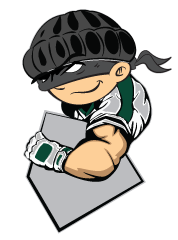Cutoffs and Relays
Matt Talarico, StealBases.com
Teams that emphasize aggressive base running will also begin to be able to defend aggressive base running. When you are constantly being tested you learn to be where you are supposed to be when you are supposed to be there. As a coach, this is one of the most difficult areas to get new players to develop as a habit. I set out to make this page for them but I really think it can be a beneficial coaching tool.
We can break it down to a few situations. Although it can seem like a lot to take on, it is really pretty simple-we need to make sure all bases are covered, while having cutoffs and backups. Where is your position and where are they going?
There is probably a better way to organize these but I think this should cover everything.
None of these videos are mine and can all be found by clicking the “full video” button to take you to the youtube page. Thanks!
Bases Empty
Special notes: Some teams will use the catcher to actually trail the runner at first, using the pitcher as the deep backup. I do like this option but most wheel the first baseman back around and let the catcher be the backup – as shown in the image.
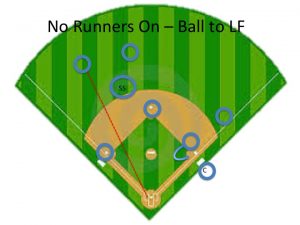
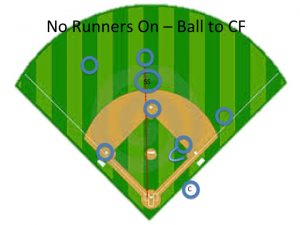
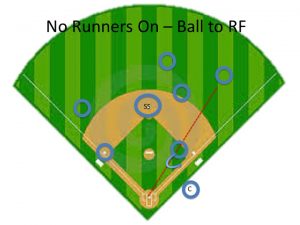
Check out my members only base stealing system, and see what college programs around the country have decided to invest in.
Balls in the gap or down the line are called sure doubles- meaning the are definitely getting a double. We no longer need to have a man at 1st and can wheel guys around to be a bit more efficient.
Special notes: A double cutoff or tandem cut is not meant to actually make 2 throws to the base. The backup cutoff, so the second baseman in the first image, is there to be sure he gets a good throw if the first cutoff man doesn’t. So if the first cutoff man is going to get a bad hop they will communicate to allow the second cutoff man to get a good hop.
- For this to work you have to be sure your spacing is good. Too much space will equal a poor hop for both cutoff men. Generally we have to encourage players to get closer to each other.
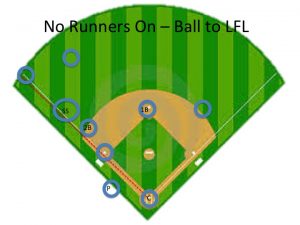
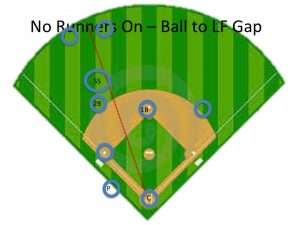
Check out my members only base stealing system, and see what college programs around the country have decided to invest in.
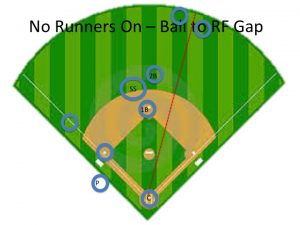
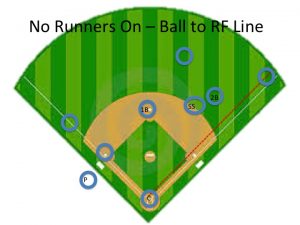
Runner on 1st
Special notes: We are looking to throw the lead runner out at third but we cannot make a poor decision allowing the hitter to move to second.
Also, cutoff men come to college without really understanding how to line up and why they should line up there.
- Cutoff men need to line themselves up for the most part.
- Generally new guys are too far out and need to get closer to the target.
- 1. We can always move out to get a ball but cannot always move back.
- 2. We have to give the player at the target base as much time to make a call as we possibly can. If we are half way between the ball and the target then the person covering the base cannot make a good decision.
- Cutoff men need to keep their feet active so they can MOVE to get a throw that isn’t perfect – I recommend adding this to your catch routine as an infielder to learn active feet.
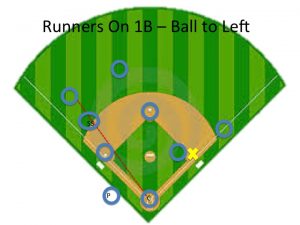
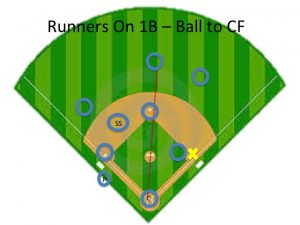
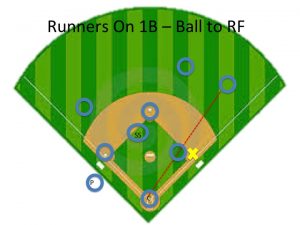
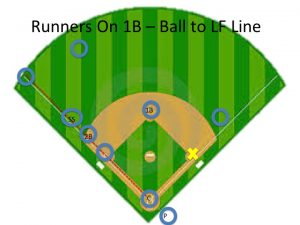
Ball to Either Gap – Line up to 3B
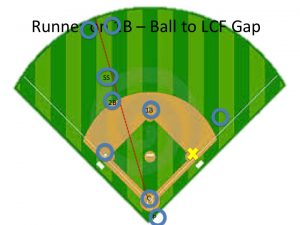
Special note: 1B would line up at mound for cutoff home – I realized I had him at 2B. Second base would be open until a decision is made – if we throw to 3B the first baseman would then trail to second, if we would throw home he would be the cutoff for the SS to home.
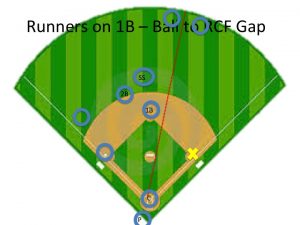
Check out my members only base stealing system, and see what college programs around the country have decided to invest in.
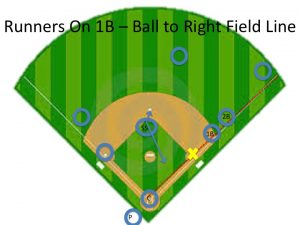
Special note: This is always a tricky one at first. This is the Jeter flip play. First and second base take the tandem cut, while SS floats.
- SS roles – 1. Redirect cut from 2B to 3B, 2. cover 2b after a round, 3. Run down a horrible throw from RF (like Jeter).
Some coaches subscribe to using the middle infielder to setup the tandem to 3B and hoping to redirect to home. I prefer the pro method.
Runner at 2nd – a ball that is a sure double would be played like nobody is on base – the guy from second will definitely score.
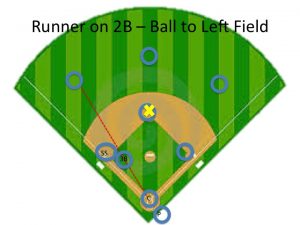
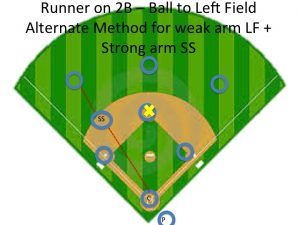
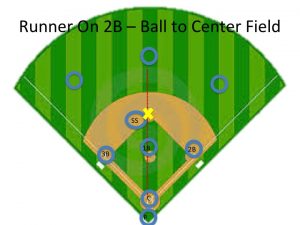
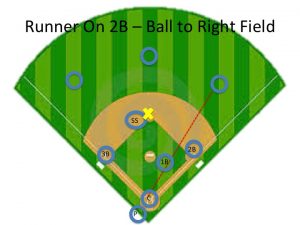
Special notes: Remember, third baseman and first baseman need to stay as deep as they can to allow a good call from the catcher. Typically they are just a target and a tool to redirect the ball to first or second. If the cutoff man catches the ball we are probably not going to get the out at home on a relay.
Runner on 1st and 2nd – Sure doubles are played as if a guy is on first (the runner at 2B will definitely score)
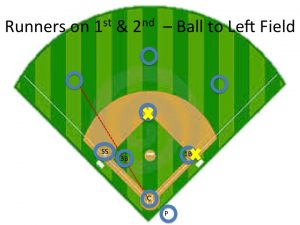
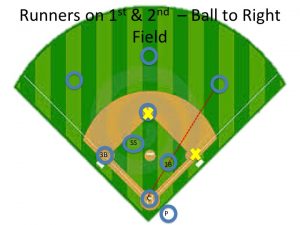
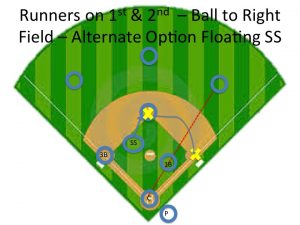
Special notes: SS needs to be an athlete. Job #1 is the cutoff to third but if the ball goes to the plate he needs to kick the 2B over to first to be a late option to cover in a rundown. This requires communication.
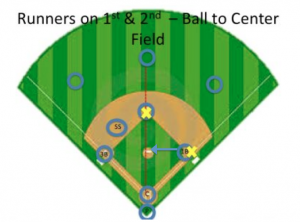
Runner at 2nd and 3rd – Balls on the ground will score runner at 3B easily, fly ball will aim to throw out lead runner and cover 3B for runner at second advancing.


Special notes: I love the quick cut option if you have a poor LF arm. It is difficult to make a decision as a 3B coach when the ball is in the infield quickly.
Bases Loaded
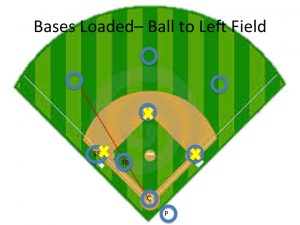
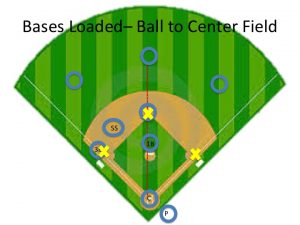
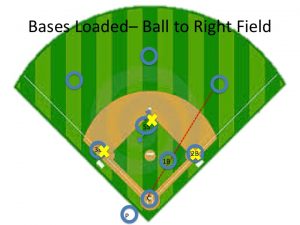
Special notes: Any ball to the right of the center fielder with a man on 2nd and 3rd or bases loaded will require the second baseman to cover first.
1st and 3B – sure doubles are played as if a runner is on first alone
Ball to RF
Runner on 3B – sure double will be played as if no runners are on.
*Bonus*
I love showing this video to our players. So much has gone wrong here. Pitcher isn’t backing up, left fielder cut the center fielders throw, looks like they have 6 cutoff men, etc.
Ball to Center – Disaster
Alternate Angle
If you are looking to improve your instincts in this area then the best thing you can do is think about it. My dad used to ask me during car rides as a kid “man on 2nd, 1 out, ball hit to RF?” I would then reply with an answer. This was always a fun trivia game between us. It became a great tool when I had to begin to figure it out on my own.
Good luck!
Check out my members only base stealing system, and see what college programs around the country have decided to invest in.
